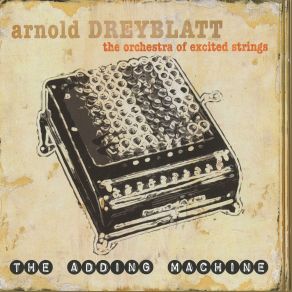The Adding Machine
Download links and information about The Adding Machine by Arnold Dreyblatt. This album was released in 2001 and it belongs to Alternative genres. It contains 5 tracks with total duration of 43:16 minutes.

|
|
|---|---|
| Artist: | Arnold Dreyblatt |
| Release date: | 2001 |
| Genre: | Alternative |
| Tracks: | 5 |
| Duration: | 43:16 |
| Buy it NOW at: | |
| Buy on iTunes $9.99 | |
| Buy on Amazon $12.70 | |
| Buy on Amazon $2.59 | |
Tracks
[Edit]| No. | Title | Length |
|---|---|---|
| 1. | International Dateline | 9:38 |
| 2. | The Adding Machine | 8:15 |
| 3. | Lapse | 7:36 |
| 4. | House of Twang | 3:12 |
| 5. | Meantime | 14:35 |
Details
[Edit]Adding to the already exciting and wonderfully varied world of sound and wonder previously released by Arnold Dreyblatt is Bang on a Can's label, Cantaloupe. Dreyblatt was responsible for "The Escalator," one of the finest moments on the Bang on a Can Allstars' Cantaloupe launching pad album, Renegade Heaven. His association with them goes back into the early '90s. For those unfamiliar, Dreyblatt uses a combination of standard instruments as well as original creations and radically transformed ones to play an overtonal tuning system based on just intonation with 20 notes per octave — as opposed to the eight we standard Westerners use. His instruments are designed to utilize the "hot overtones" he finds in his system, that are illuminated best with strings. He uses a reconfigured cimbalom that is actually a pre-war, Chinese children's piano, which is played horizontally with hammers. One of his electric guitars has built-in magnetic driver-sustainers for each string, and for both instruments, new frets have been added in the just intonation scale. His bass has been restrung with unwound steel wire and is played by being beaten and struck with a bass bow. There are other more conventional instruments such as violin, cello, double bass, hurdy-gurdy, and percussion. All of the instruments — save for percussion — perform in the 20-note-per-octave system. What does it sound like? Like a shimmering, hyperkinetic orgy of string music, dynamically arranged for maximum penetration of the cerebral cortex's pleasure center. Dreyblatt, unlike his contemporaries Glenn Branca, Rhys Chatham, and others, doesn't need to knock the listener down with his music; it naturally establishes ostinato rhythmic patterns, textural balances, and tonal symmetry. The title track, with its snare drum underlining the cimbalom and cello as the other strings pulse and vibrate, is a case in point. Elsewhere, in the gargantuan "Meantime," percussion creates a type of Morse code that is very gradually extrapolated upon by the stringed instruments even as new rhythmic patterns appear in the middle of established ones. Certainly it is tempting to merely label this music minimalism, but to do so would be erroneous because so much happens in the midst of pulse patterns and pedal, points in which harmonics are literally being created every moment as it unfolds over 14 minutes with certain instruments taking center stage for a few moments and then fading as others are asserted into the mix. The conclusion is dramatic and profound, but not without humor and great beauty. This is a mysterious music that is at once enchanting, engaging, and accessible. This is a brilliant piece of work by a composer who, though he's been around a time or three, is just hitting his stride.